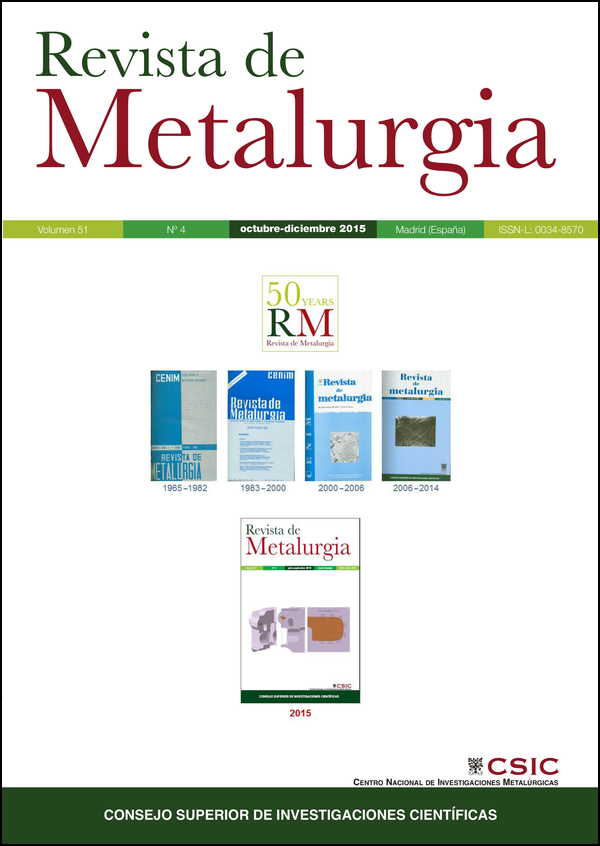Thermodynamic analysis of the reduction process of Colombian lateritic nickel ore
DOI:
https://doi.org/10.3989/revmetalm.057Keywords:
Ferro-nickel reduction, Nickeliferous laterite, Ratio C/O, Thermodynamic analysisAbstract
The Colombian nickeliferous laterites are minerals used for the nickel extraction by hydrometallurgical and pyrometallurgical processes. In this work the thermodynamic behaviour of three Colombian lateritic mineral samples are described, with contents of 1.42%, 1.78% y 2.04% of nickel, when they are subjected to the calcination and reduction processes. The mineral was characterized using X Rays Diffraction and X Rays Fluorescence, giving evidence of the presence of mineralogical species such as nepouite (Ni3Si2O5(OH)4), goethite (Fe2O3.H2O), silica (SiO2), antigorite (Mg3Si2O5(OH)4) and fosferite (Mg2SiO4). The thermodynamic analysis was conducted using the software HSC Chemistry for Windows 5.1 and was focused in the quantitative determination of the chemical evolution of the mixture of these minerals with variable quantities of coal, in function of temperature. The results produced by the program showed, in the equilibrium, the feasibility of complete reduction of the nickel, and additionally, a considerable high percentage of reduction of iron oxides (up to 99%) using ratio C/O ≈1 at temperatures close to 1100 °C.
Downloads
References
Dalvi, A.D., Bacon, W.G., Osborne, R.C. (2004). The Past and the Future of Nickel Laterites, PDAC 2004 International Convention, Ontario, Canada, pp. 1–27. http://www.pdac.ca/docs/default-source/publications—papers-presentations—conventions/techprgm-dalvi-bacon.pdf?sfvrsn=4.
Girgin, ?., Obut, A., Üçyildiz, A. (2011). Dissolution behaviour of a Turkish lateritic nickel ore. Miner. Eng. 24 (7), 603–609. http://dx.doi.org/10.1016/j.mineng.2010.10.009
Huang, Q., Lv, X. (2011). Phases transformation of nickel lateritic ore during dehydration. J. Min. Metall. Sect. B- 47 (1), 45–51. http://dx.doi.org/10.2298/JMMB1101045H
Oxley, A., Barcza, N. (2013). Hydro-pyro integration in the processing of nickel laterites. Miner. Eng. 54, 2–13. http://dx.doi.org/10.1016/j.mineng.2013.02.012
Pickles, C.A., Harris, C.T., Peacey, J., Forster, J. (2013). Thermodynamic analysis of the Fe–Ni–Co–Mg–Si–O–H–S–C–Cl system for selective sulphidation of a nickeliferous limonitic laterite ore. Miner. Eng. 54, 52-62. http://dx.doi.org/10.1016/j.mineng.2013.03.029
Ramírez, A.C., Serrano, A.R., Salinas, E.R., López, A.R., Ramírez, M.V. (2008). The solubility and activity determination of NiO in the SiO2–NiO–FeO system. J. Non- Cryst. Solids 354 (30), 3533–3539. http://dx.doi.org/10.1016/j.jnoncrysol.2008.03.027
Rao, M., Li, G., Jiang, T., Luo, J., Zhang, Y., Fan, X. (2013). Carbothermic Reduction of Nickeliferous Laterite Ores for Nickel Pig Iron Production in China: A Review. JOM 65 (11), 1573–1583. http://dx.doi.org/10.1007/s11837-013-0760-7
Rodríguez, R., Londo-o, J., Garzón, E., Forero, J., Manrique, J., Rojas, W. (2009). Níquel en Colombia. Unidad de Planeación Minero Energética, Bogotá, Colombia. http://www.upme.gov.co/Docs/Niquel_Colombia.pdf.
Tanaka, Y., Ueno, T., Okumura, K., Hayashi, S. (2011). Reaction Behavior of Coal Rich Composite Iron Ore Hot Briquettes under Load at High Temperatures until 1400 °C. ISIJ Int. 51 (8), 1240–1246. http://dx.doi.org/10.2355/isijinternational.51.1240
Published
How to Cite
Issue
Section
License
Copyright (c) 2015 Consejo Superior de Investigaciones Científicas (CSIC)

This work is licensed under a Creative Commons Attribution 4.0 International License.
© CSIC. Manuscripts published in both the printed and online versions of this Journal are the property of Consejo Superior de Investigaciones Científicas, and quoting this source is a requirement for any partial or full reproduction.
All contents of this electronic edition, except where otherwise noted, are distributed under a “Creative Commons Attribution 4.0 International” (CC BY 4.0) License. You may read the basic information and the legal text of the license. The indication of the CC BY 4.0 License must be expressly stated in this way when necessary.
Self-archiving in repositories, personal webpages or similar, of any version other than the published by the Editor, is not allowed.
















